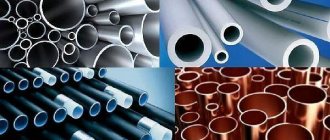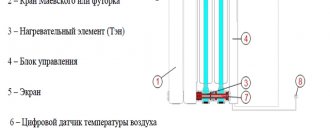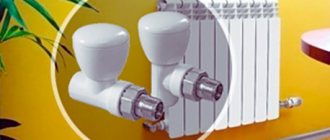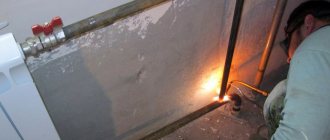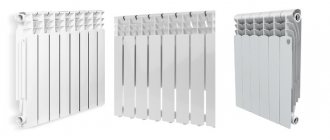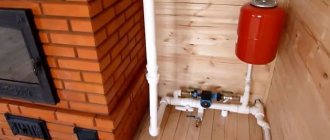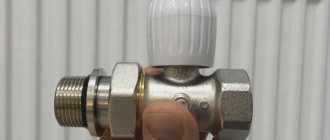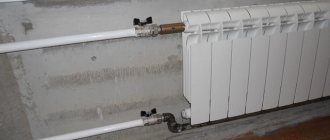To carry out adjustment, maintenance or repair of heating systems, various pipeline fittings are used. Today, ball valves for heating have become especially popular as the simplest and most reliable devices for shutting off the coolant. On the modern market they are presented in a wide range, which sometimes makes it difficult to choose the right product. The purpose of this article is to help you figure out which ball valves are worth buying for heating installation in a private house or apartment.
Why are there taps on radiators?
Each heating device is a separate element of the system that requires adjustment and periodic maintenance. If you control the coolant flow through the batteries depending on the heat demand, you can achieve good results in terms of energy savings. That is, radiator valves and heating taps are designed to solve the following problems:
- Complete isolation of the heating device from the system.
- Restriction of coolant flow through the battery.
- Change in coolant flow depending on external conditions.
- Bleeding air from the radiator and piping network.
There are many situations in which it is difficult to do without disconnecting the battery. For example, properly working central heating in the middle of spring, when it’s already warm outside, but it’s just hot in the apartment. Another case is the need to remove a heating device for the purpose of replacement, flushing or repair. In the absence of shut-off valves, carrying out any action with the radiator becomes problematic.
Valves are also installed on batteries in retro style
Restriction of the flowing coolant is carried out in order to balance individual heating in a private house or apartment. No matter what type of heating system you have, without balancing with valves, the first radiators will always receive more water than the last ones. Limiting the coolant flow at the beginning of the network and thereby balancing all devices with each other is the task of the control radiator fittings.
Automatic control of the flow of incoming coolant is a way to save energy used to heat the house. If each tap on the heating radiator maintains the set air temperature in the room by controlling the flow of water through the radiator, then in general the system will consume only the required amount of heat, no more. And this is a considerable saving.
Well, the problem of air release when filling the system or during operation is also solved by special air valves installed on all modern radiators. Below is a list of types of shut-off and control valves, listed in the same order as the tasks they solve:
- Half-turn ball valves in straight and angle versions. Made from brass, bronze or polypropylene with a metal insert.
- Balancing valves for radiators – straight and angular.
- Regulating valves with thermal heads (thermostatic valves).
- Air drain valves – automatic and manual.
For reference. Some home craftsmen use three-way mixing valves to connect heating appliances. But such a solution is unreasonably expensive and is rarely used in practice.
Now we should consider in detail which taps are best installed on radiators in various conditions and circumstances. Some options are clearly shown in the video:
Heating tap versions
Heating taps are produced in several versions - full bore and part bore:
- the first pass up to 100% of the flow, with minimal hydraulic losses;
- the second, depending on the model, can pass up to 80%, the third up to 50% of the flow.
For work in the heating network, it is advisable to use full bore valves. They guarantee that there will be no significant obstacles in the path of the coolant flow, which has a beneficial effect on indoor comfort. By the way, valves made of polymer materials cannot be installed in the heating network. Such taps do not withstand high temperatures very well.
Brass taps used for heating appliances are divided according to the connection method:
- coupling;
- flanged;
- welded;
- combined.
The first type of ball valves is used for heating installation; in addition, they are used in water and gas supply systems. They can be found in systems installed in residential buildings, industrial buildings and other types of buildings. To install coupling-type ball valves, no special equipment is required; a set of plumbing wrenches is sufficient. Coupling valves are used in pipelines with a nominal diameter of up to 45 mm. For systems with large diameters, flanged valves are used.
For their installation it is necessary to use gaskets. As a rule, they are made from paronite. Ball valves with a flange connection have a large margin of safety, and a connection of this type provides the necessary tightness, which allows them to be used in heating systems.
Cranes of this type are produced in collapsible and solid versions. The good thing about a collapsible crane is that if a malfunction occurs, it can be easily dismantled, disassembled and the malfunction repaired. The one-piece shells are made in a molded casing and if it fails, it will have to be completely replaced.
Weld valves
Welded valves are mounted into the system by welding. The practice of designing and installing systems shows that cranes of this type are installed in hard-to-reach places. By the way, if you don’t have special skills, then it doesn’t make sense to install them yourself. To weld valves, the welder must have a special permit.
In combination cranes, several types of installation can be implemented. These cranes come in various designs:
- walk-through;
- corner;
- multi-pass.
Multi-way valves are rarely used in heating systems.
Multi-port valves
There are often cases when, instead of high-quality brass, manufacturers use silumin and its derivatives. Their appearance resembles faucets made of brass and traders often pass them off as quality products. There is no point in installing them in thermal systems. Silumin is not highly resistant to stress and corrosion. Their service life is approximately one year, after which they must be replaced. There are known cases when taps made from this material simply fell off heating appliances.
Heating radiators are only part of the heating system of a building. Heat can be supplied to the building either from boiler equipment installed in it or from a centralized network. In the second case, the carrier passes through the ITP (individual heating point).
It receives coolant from the central city (district) network. It can be water or steam. Heat exchange occurs in the IHP. That is, the coolant poured into the house network takes away the heat coming from it. It also heats the water sent to the building’s hot water supply.
Ball valves are used as shut-off valves. One valve is installed at the entrance to the ITP, and many valves of different diameters are used to direct the flow from pumps to heaters, etc. In such equipment, valves of different designs are used - welded, coupling and others.
Installation of ball valves on batteries
A conventional ball valve is designed only to switch to 2 positions: “open” and “closed”. It cannot be used to regulate the flow of coolant through the radiator, only shut it off. The figure below shows a simple connection diagram for a heating device with this type of fittings:
The proposed scheme is the best option for an unregulated connection of a radiator to the central heating risers in an apartment. You won’t have to balance it anyway, and installing a thermostatic valve is pointless due to the poor quality of the coolant. Instead of a ball valve at the outlet, it is also practiced to install a so-called shut-off valve; its difference is only in appearance.
Depending on the layout of appliances and heating pipes, you can choose an angle valve for a radiator with or without a decorative coating. Also, when choosing a product, it is recommended to pay attention to the operating pressure indicated on the product body or in its passport. It must correspond to the pressure in the heating network of the apartment building.
Advice. For installation on the radiator, choose good taps made of thick-walled brass and a connection with an American union nut. It will allow you to quickly disconnect the connections without rotating the elements. On a single-pipe riser, do not forget to install the bypass with a slight offset away from the main pipe.
Recommendations for choosing a ball valve
Now that we have figured out what this or that type of ball valve is intended for, we can begin to select it. It should be remembered that this type of fittings is not used to regulate the amount of water, but only performs shut-off functions. The exception is devices with servo drives. It is better to make a specific selection of a tap knowing the operating parameters of the coolant. If there is no such information, then it is enough to know that for systems of private houses, fittings in a coupling design with a working pressure of up to 10 Bar and a temperature of up to 120 ºC are quite sufficient.
If we are talking about centralized networks, then for heating it is better to use ball valves with a working pressure of up to 16 Bar and higher. When selecting fittings for central heating, you need to be careful and provide a decent pressure margin. The reason is unpredictable parameter jumps due to water hammer.
Separately, we will give a warning about counterfeits, which fill all plumbing markets. The Chinese cheap faucet is made of silumin, it is very fragile and often cannot withstand even tightening with a wrench. In addition, the material is susceptible to electrochemical corrosion, which destroys it within a couple of years. At the same time, it has become very difficult to recognize a fake. The only recommendation on this topic: buy fittings from trusted people or in trusted stores, even if you choose a small tap for heating radiators.
Balancing valve
The design of a valve for regulating heating differs from a conventional ball valve in that it can smoothly close the flow area in a few turns. Moreover, after balancing, the position of the valve can be fixed so that no one accidentally violates the settings. This type of control valves is installed at the outlet of the radiator, as shown in the diagram:
Shown here is the connection to a two-pipe horizontal system, most common in private houses and apartments with individual heating. By the way, the principle of installing fittings with a single-pipe scheme remains the same. A regular ball valve is installed on the supply line, and an adjustment valve is installed on the return line. In the case when a two-story house has a system with vertical risers, the installation diagram of the accompanying fittings looks like this:
The principle of product selection is the same as in the previous section. Straight or angular design is accepted depending on the layout of the equipment and pipelines; it is also important to use American ones during assembly. Pay special attention to the quality of casting and the thickness of the brass walls of the fittings. If you have networks made of polypropylene pipes, do not rush to buy PPR taps; it is better to install adapters and reliable metal products.
Advice. Balancing valves are installed on all radiators, except for the very last one, located at the dead end of the branch. It is enough to install simple ball valves on the connections to it.
What is better: faucet or valve?
A homeowner often faces this question. And I must say that there is no clear answer to it. We can only note that the ball valve is easy to operate. The shut-off valve, in contrast, must be turned several times; this is the only way to limit or increase the supply of the working medium.
The faucet includes valves with gaskets on them. After they have exhausted their service life, they can simply be replaced, the same applies to the oil seal. Ball valves do not cause such problems. The only thing is that it is necessary to periodically inspect them and, if a leak is detected, take replacement measures.
If hard water circulates in the heating network, then it makes sense to think about installing a shut-off valve; if problems arise, it can be repaired, since the ball valve will have to be replaced.
The price of the issue also plays an important role.
A little about refusals
Unfortunately, failures in the heating system are not that uncommon. This is due to the low quality of the pipeline fittings used. In particular, these include ball valves made of silumin, as discussed above, and the use of low-quality substitutes instead of fluoroplastic.
Currently reading
- How it works and how the Mayevsky crane works
- Why are coupling cranes pushing their counterparts out of the market?
- Applications for double control taps
- What are the purposes of three-way valves in water supply?
Using valves with thermal heads
These are the best taps that can be installed on radiators in the heating system of a private home. Tuned to a certain air temperature, the thermal head acts on the valve stem, forcing it to open or close its flow area. In this way, automatic quantitative regulation of the coolant passing through the heating device occurs.
The thermostatic valve is installed on the supply line to the battery, and a balancing valve is installed on the return line. It is a mistake to assume that the system will be automatically balanced by thermal heads; valves are needed in any case. Installation of conventional ball valves instead of them is allowed for centralized heating or in systems with associated coolant movement (Tichelman loop). But it is unacceptable to regulate the coolant flow using a ball valve, and it will not work.
Advice. Most models of thermal valves have a mechanical blocking mode for the flow area. If you received products without such a mode, then to service the battery you will have to install an additional cut-off device, as shown in the diagram:
Air valves and radiator fittings
Almost all modern radiators provide the possibility of installing Mayevsky manual valves for air discharge. Some manufacturers even complete their products with them. If desired, instead of a manual air vent, you can install an automatic one, but in practice it does not look very presentable.
Recently, laying heating lines below floor level and using radiators with bottom connections has become increasingly popular. Then there remains a small gap between the battery and the floor, where it is not always possible to place any fittings. For this case, there is a special connection headset with built-in taps, shown in the picture (left):
On the right is a headset for the bottom connection of a conventional radiator with side plugs; it also has valves plus the ability to connect a thermal head. Such solutions look very aesthetically pleasing, but will require maximum financial costs. More information about the headset is shown in the video:
